 |
||||||||
 |
||||||||
 |
||||||||
|
|
||||||||
|
|
||||||||
|
|
||||||||
|
|
||||||||
|
|
||||||||
|
|
||||||||
|
|
||||||||
|
|
||||||||
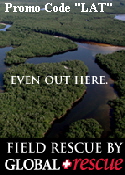 |
||||||||
|
|
||||||||
|
|
||||||||
 |
|
|
|
|
|
|
Florida's Exciting New Bass Research Center Hatchery Opens By Larry Larsen
Florida is world-renowned as the "Fishing Capital of the World." Largemouth bass are the most popular freshwater sport fish in the United States; the Florida strain is hugely prized by anglers because it reaches a larger size than its northern cousins. The $17.5 million Florida Bass Conservation Center replaces the agency's 1960s era facility at Richloam State Fish Hatchery. The outdated hatchery played an important role in freshwater fisheries management for nearly 40 years. However today's conditions call for updated technology and new techniques to meet the challenges of modern fish management. The new facility will be able to produce up to three times as many fish annually as the old hatchery.
The new, 21st century facility will conserve water, reduce fish loss to predators, and produce disease-free fish with the right genetic makeup to ensure their best possible chance of survival in the waters in which they are stocked. Unlike the old hatchery, the Florida Bass Conservation Center is a climate-controlled rearing and research facility. The fish are spawned and raised indoors, in long, concrete tanks called raceways instead of outdoor earthen ponds. These technological advances allow more fish to be produced per gallon, at a much lower cost per fish. Using raceways also reduces predation by birds, saves water and energy, and allows better control of parasites and diseases. New fish feeding technology is also being developed at the center and, along with state-of-the art filtration systems, will help fish grow faster and decrease mortality . The facility recycles 90% of the water used for fish production inside the building, and 100% of the water used for fish production in outside ponds and tanks. Through genetics monitoring, the Center will ensure preservation of the unique strain of Florida largemouth bass. A fish pathology lab will monitor the health of fish being reared at the hatchery. The 39,000 square feet Florida Bass Conservation Center building also contains:
Future Growth Needs The facility will be open to the public in April or May, according to FWC biologist Bob Wattendorf. Tours of the facility will be offered at that time. In the future however, a grand Public Education and Visitor's Center will be constructed. The proposed $7 million addition to the facility will be paid for primarily through private donations and sponsorship. To make a contribution to the future of the FBCC, those interested can visit MyFWC.com/Fishing/FBCC. Darrell Scovell, the Director of the Division of Freshwater Fisheries Management, anticipates that addition and the FBCC will provide visitors with the latest information about Florida fisheries biology, freshwater fishing techniques and aquatic habitats. Not only will there be educational displays, trails and observation facilities, but also fishing ponds and instructions will ultimately be provided. That's projected once they get the funding. "The Wildlife Foundation of Florida (WFF) is also helping secure funding for the visitor's center by collecting donations," says Wattendorf. "One great way to donate to the FBCC is by purchasing one of Glen Lau's prints, videos or DVDs. Mr. Lau is the preeminent bass photographer/cinematographer in the world. He has graciously offered the use of his art at the FBCC and now is allowing the WFF to sell his creations, including the awesome "Bigmouth" and "Bigmouth Forever" videos, with all the profits going to the FBCC."
The Sunshine State is recognized as the "Fishing Capital of the World" based on a number of factors, according to Wattendorf. Among the most important is information provided by the a recent National Survey of Fishing, Hunting and Wildlife-Associated Recreation that shows Florida is the number one recreational fishing state in terms of number of anglers, number of angling days, direct economic impact, jobs supported and many other important factors. The state attracts 3.1 million anglers, who fish 48.4 million days, spend $4.1 billion, and support 80,000 jobs. Historically, the state fisheries agency deemed stocking fish to be unnecessary because natural conditions in Florida waters supported thriving populations of bass. Reproduction was thought to be more than adequate to replace natural mortality and what anglers' harvested. However, development, agricultural runoff, drained wetlands, and stabilized water levels have changed environmental conditions. In some instances, these changes have created circumstances which limit bass survival in the early months of life. Stocking advanced fingerlings (5– 6-inch baby bass) increases the likelihood that more bass will reach the size anglers desire. The new FBCC facility will produce a variety of freshwater fish including Florida largemouth bass, striped bass, sunshine bass, bream and channel catfish. With the ever-changing Florida landscape, the truly impressive Florida Bass Conservation Center should help the FWC meet increasing demands on Florida's freshwater fisheries and ensure safe and sustainable use of these resources. Editor's Note: For more information, contact the Florida Fish and Wildlife Conservation Commission at (850) 488-4676 or visit their website at www.MyFWC.com. To order one of Glen Lau's prints, videos or DVDs (with all profits going to the FBCC), visit www.WildlifeFoundationofFlorida.org |
|||||||||
|
|
|
|
|||||||
|
|
|||||||||
|

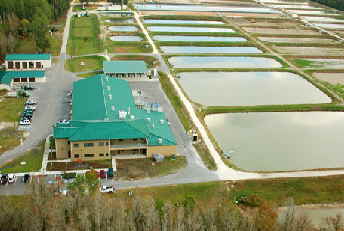 In late February (2007), the Florida Fish and Wildlife Conservation Commission (FWC) unveiled the Florida Bass Conservation Center (FBCC), a
new state of the art hatchery and research center for the propagation and conservation of the unique Florida strain of largemouth bass. The center is located on 186 acres in the heart of the
Withlacoochee State Forest just off State Road 471 (16 miles north of the highway 98 junction) in Sumter County.
In late February (2007), the Florida Fish and Wildlife Conservation Commission (FWC) unveiled the Florida Bass Conservation Center (FBCC), a
new state of the art hatchery and research center for the propagation and conservation of the unique Florida strain of largemouth bass. The center is located on 186 acres in the heart of the
Withlacoochee State Forest just off State Road 471 (16 miles north of the highway 98 junction) in Sumter County.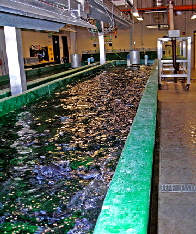 Hi-Tech Advances Throughout
Hi-Tech Advances Throughout
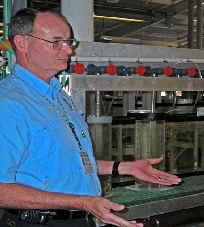 Outside facilities include 66 ponds that range from 0.25 acres to 1.5
acres and 14 harvest pavilion tanks that are 2,000 gallons each.
Outside facilities include 66 ponds that range from 0.25 acres to 1.5
acres and 14 harvest pavilion tanks that are 2,000 gallons each. 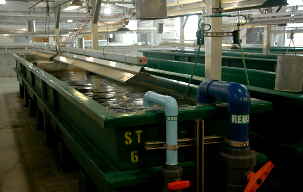 State Fishing Waters Will Benefit
State Fishing Waters Will Benefit